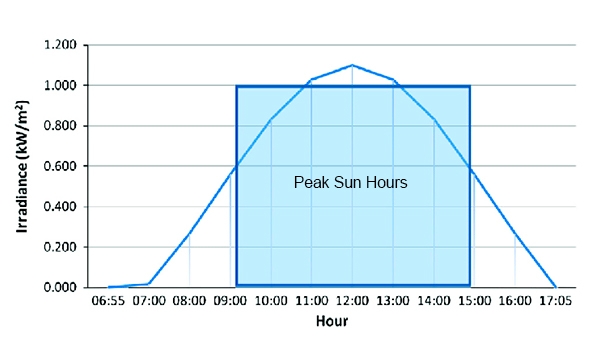As one of the most sustainable energy sources, solar energy has received a lot of attention. After all, sunlight is free and abundant! But what is the peak sunshine time? If you have solar panels or are considering using solar energy, you may be confused about this. Understanding this concept is important if you want to maximize the efficiency of solar cell panels and accurately estimate their power generation.
Definition of peak sun hours:
Peak sun hours is a term used to quantify the amount of solar energy available at a specific location during a day. It represents the number of hours in a day when the solar irradiance is equal to a certain value, typically defined as 1000 watts per square meter (W/m2), which is considered the maximum possible solar power under perfect conditions.

In other words, peak sun hours indicate how much solar energy an area receives over the course of a day. For example, if a location receives 5 peak sun hours in a day, it means that the total solar energy it receives throughout the day is equivalent to the energy it would receive if the sun shone at its peak intensity (1000 W/m2) for 5 hours straight. Peak sun hours can vary based on location, time of year, and weather conditions. They are a critical measure for solar energy calculations, helping to estimate how much solar power a pv solar panel can generate in a specific area and allowing for more accurate planning and installation of solar energy systems.
However, do not confuse peak hours of sunlight with total daytime time - they are different. The daytime time constitutes the entire time between sunrise and sunset. The solar peak period refers to the period when the solar intensity is sufficient for efficient solar power generation.
What are the factor influencing peak sun hours?
- Geographical Location. The closer a location is to the equator, the more direct sunlight it receives throughout the year, resulting in more peak sun hours. Conversely, areas closer to the poles may experience fewer peak sun hours, especially during winter months.
- Season. The time of year can impact the angle of the sun and the length of daylight, affecting the amount of sunlight received. Summer months typically have longer days and more direct sunlight, resulting in more peak sun hours.
- Weather Conditions. Cloud cover, rain, fog, and other weather conditions can reduce the amount of sunlight reaching the surface, thereby decreasing the peak sun hours.
- Altitude. Higher altitudes can receive more direct sunlight and less atmospheric interference, resulting in more peak sun hours.
- Orientation and Tilt of Solar Panels. Photovoltaic solar panels positioned to face the sun directly and at the optimal tilt angle can maximize the capture of solar energy and increase the effective peak sun hours.
- Time of Day. The sun is at its highest point and most direct at solar noon, which is typically when peak sun hours are greatest.
- Air Quality. High levels of pollution or particulate matter in the atmosphere can scatter or absorb sunlight, reducing the amount of sunlight that reaches the ground.
- Obstructions. Buildings, trees, or other obstructions that shade an area can decrease the available sunlight and thus the peak sun hours.
Importance of peak sun hours in solar energy:
Peak sun hours play a crucial role in solar energy generation because they represent the amount of sunlight energy available at a location for solar power generation. Here are some reasons why peak sun hours are important in solar energy:

- Energy Production Estimation. Peak sun hours help in estimating the potential energy production of solar photovoltaic panels in a specific location. By knowing the average peak sun hours in a given area, you can calculate how much energy your solar panel system can produce in a day.
- System Sizing. Understanding peak sun hours helps in sizing a solar power system appropriately. It allows for the design of systems that match the energy needs of a building or home by calculating the required number and size of solar plates.
- Economic Feasibility. Knowing the peak sun hours can help determine the economic feasibility of installing a solar energy system. It helps assess whether the system will generate enough electricity to offset the costs of installation and maintenance over time.
- Comparison of Locations. Peak sun hours allow for comparison between different locations for solar energy potential. Locations with higher peak sun hours are generally more suitable for solar power generation, making it easier to choose the best site for a solar installation.
- Performance Optimization. By analyzing peak sun hours, sun panel installers can optimize the positioning and orientation of panels to maximize energy production during the times of day when sunlight is most intense.
- Planning and Forecasting. Peak sun hours data helps with long-term planning and forecasting for energy needs. By understanding the seasonal variations in sunlight, solar power generation can be planned accordingly.
The peak hours of sunlight are a key indicator in the solar energy industry, which helps determine the potential energy production of powerness solar panel systems. By understanding this concept and the factors that influence it, you can make wiser decisions about solar installations and optimize your system for maximum efficiency and cost savings. Whether you are considering home solar energy or just exploring this field, understanding the peak hours of sunlight can provide valuable insights into the solar world. If you want to know more about our products, inverter.com will help you.
